Crabapple Trees (Malus): Types, Flowers, Fruits (Pictures)
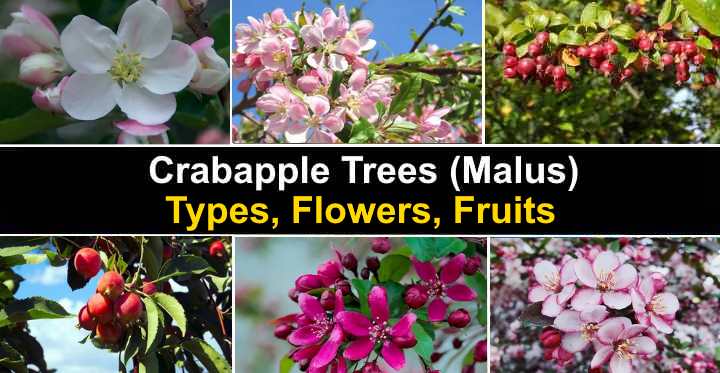
Crabapple trees are stunning ornamental flowering trees. Crabapple flowers come in spectacular shades of pink, white, cream, purple, orange, and red. Crabapple trees produce small fruits called crabapples that generally have a tart taste. The colorful miniature apples often stay hanging on the tree long after the leaves have dropped in the fall.
Crabapple trees (botanical name Malus) are like miniature apple trees (Malus domestica). The smallest crabapple trees can be small shrub-like bushes around 4 ft. (1.2 m) tall. Larger crabapples can grow to between 20 and 30 ft. (6 – 9 m). Most crabapple trees thrive in zones USDA 4 through 8. However, some cultivars are cold-hardy to zones 2 or 3.
The most attractive aspect of crabapple trees is their delightful spring blossoms. The wide, spreading branches are covered in various pastel shade flowers. The bark of crabapple trees is gray with a scaly appearance.
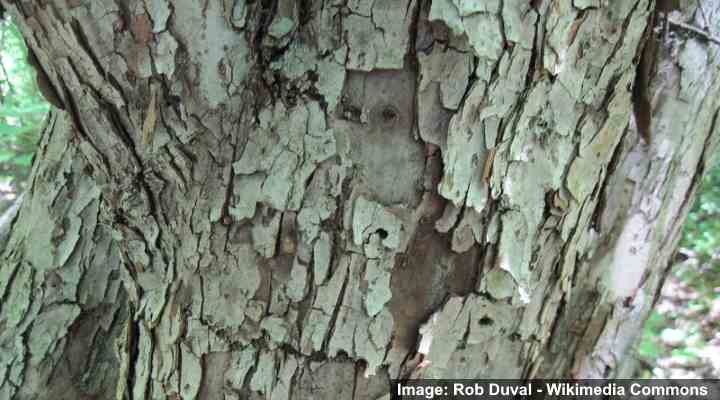
Bark of a sweet crabapple (Malus coronaria) tree
In this article, you’ll find descriptions and pictures of the most common crabapple varieties. Find out the best kinds of crabapples to grow in your backyard to add year-long interest to your garden landscape.
Crabapples vs. Apples
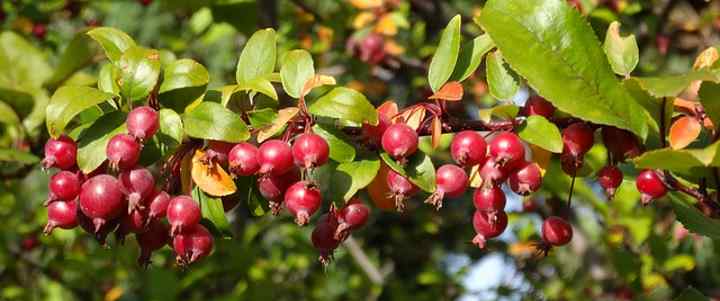
Crabapples
Crabapples are much smaller fruits than regular apples and generally have a tarter taste compared to regular apples. Crabapple trees produce fruits that are generally up to 2” (5 cm) in diameter. Traditional apple trees produce fruits that are larger than 2” (5 cm) in diameter.
Crabapple fruits can have a wide range of colors such as yellow, amber, orange, red or purple. Crabapple fruits are about the size of golf balls or smaller. However, they can grow on the tree like clusters of small berries.
Can You Eat Crabapples?
Crabapples are an edible type of fruit but they generally have a tart taste so you wouldn’t like to eat them raw. Because crabapples generally have a tarter taste than regular apples, they are used in cooking recipes. Popular ways to eat crabapples are jellies, sauces, pickled crabapples, and jams. However, even after cooking, some crabapple varieties are still too sour to eat.
There are a few juicy and tasty crabapple varieties such as Dolgo, Callaway, Centennial, Chestnut, Wickson, and Whitney crabapples.
Crabapple Tree Flowers (Crab Apple Tree Blooms)
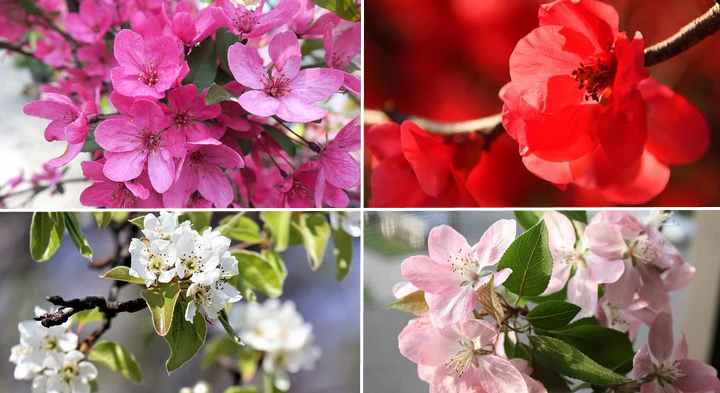
The beautiful flowers of crabapple tree come is various colors
Crabapple flowers have five or more small oval petals that can form single or double blooms. The magnificent floral crabapple displays in spring can be blooms of whites, pinks, reds, or purples—with many hues and shades in between.
What Are the Best Types of Flowering Crabapple Trees?
Seeing a crabapple tree in bloom in spring is a stunning sight. To choose the best crabapple trees for your yard, consider the colors you want from your tree, size of the tree, and type of fruit—tart or sweet crabapples.
Here are some of the best crabapple tree varieties that produce colorful flowers every spring:
- Prairifire crabapple trees. The rounded growth on prairifire crabapples has masses of dark pink to red flowers in late spring. This flowering crabapple tree is a small ornamental tree for sunny gardens.
- Royal Raindrops crabapple trees. Magenta-pink blooms appear in mid-spring on crabapples ‘Royal Raindrops.’ This crabapple species has unusual deeply-lobed leaves and produces tiny apple fruits.
- Lollipop crabapple trees. Spectacular white flowers spear in spring. This dwarf apple tree has upward growing branches and small amber-colored apples.
- Robinson crabapple trees. This crabapple variety is a pink-flowering tree with a rounded shape and medium height. Fruits from ‘Robinson’ crabapple trees are red-skinned and popular for making jellies.
- Sugar Tyme crabapple trees. ‘Sugar Tyme’ Malus produces masses of showy white and pink flower clusters in mid-spring. The crabapple tree blossoms emit sweet scents, and the small red apples stay on the branches after the leaves drop in fall.
Types of Crabapple Trees (With Pictures)
Here are some of the more stunning flowering crabapple trees to plant in your front or backyard.
Prairifire Crabapples (Malus ‘Prairifire’)
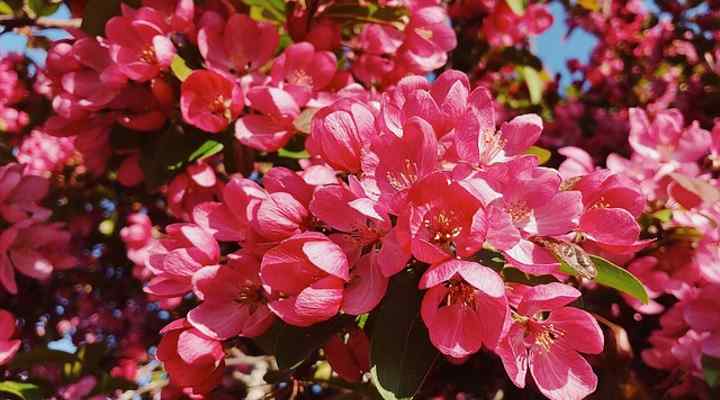
Prairifire crabapple (Malus ‘Prairifire’) has dark pink-red flowers
‘Prairifire’ crabapple trees are ornamental flowering trees producing clusters of deep pink-red spring flowers. ‘Prairifire’ crabapples grow up to 20 ft. (6 m) tall with a spread of 15 ft. (5 m). The crabapple tree bark is gray and scaly.
The dense rounded growth of the ‘Prairifire’ crabapple tree looks stunning in all seasons. After the dark pink or red flowers finish blooming, reddish-purple ovate leaves appear that become dark green. In the fall, the tree’s foliage turns a warm orange color. Then purplish-red small sweet crabapples appear that last on the tree until winter.
Plant ‘Prairifire’ crabapples trees in full sun and well-draining soil. The trees are fairly drought tolerant and grow in many different soil types. Grow in USDA zones 3 to 8.
Robinson Crabapple (Malus ‘Robinson’)
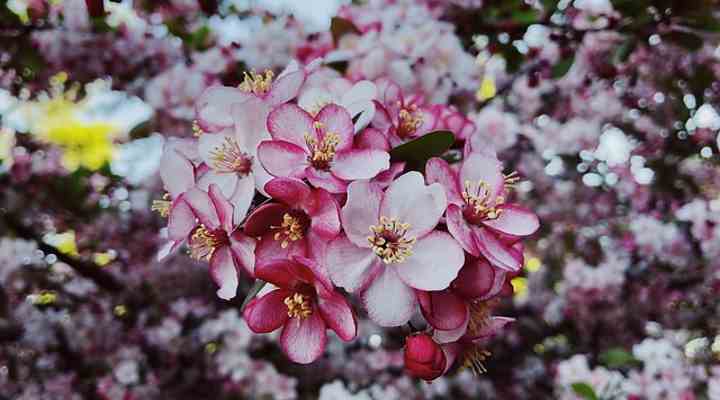
Robinson crabapple (Malus ‘Robinson’) pink blooms
‘Robinson’ crabapples are prized decorative flowering landscape trees due to their showy pink flowers. This crabapple variety has oval leaves that are purple before turning green with hints of red and then turning orange in the fall. The edible red crabapples are just under 1 cm in diameter, and the red fruit clusters last until winter.
‘Robinson’ crabapples are suitable for growing in zones 4 through 8. The easy-care crabapple trees are reasonably tolerant of drought and only require minimal pruning in winter. As with most varieties of crabapples trees, plant in full sun for best results.
Sargent Crabapple (Malus sargentii)
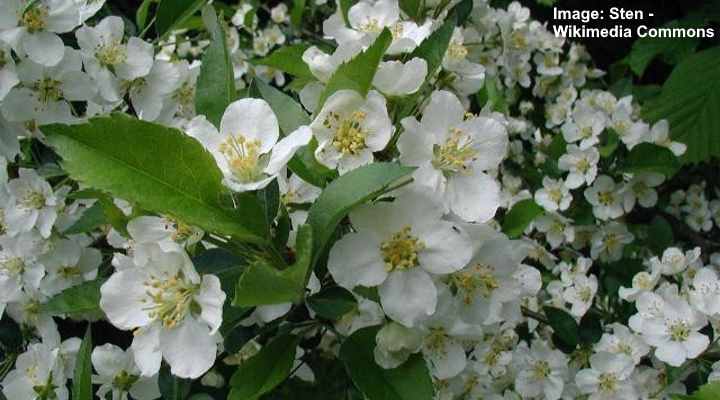
White blossoms on Sargent crabapple (Malus sargentii) tree
‘Sargent’ crabapple is a dwarf landscape tree with masses of sweetly-scented white flowers. The small crabapple tree produces tiny crabapples that look like clusters of red berries. ‘Sargent’ crabapple trees grow between 6 and 10 ft. (1.8 – 3 m) tall with a dense crown growing horizontally. The tree has a spread up to 12 ft. (3.6 m) wide.
‘Sargent’ crabapples also grow as small flowering shrubs. You can plant Sargent crabapple bushes as flowering hedge plants, borders, or privacy screens.
Lollipop Crabapple (Malus ‘Lollizam’)
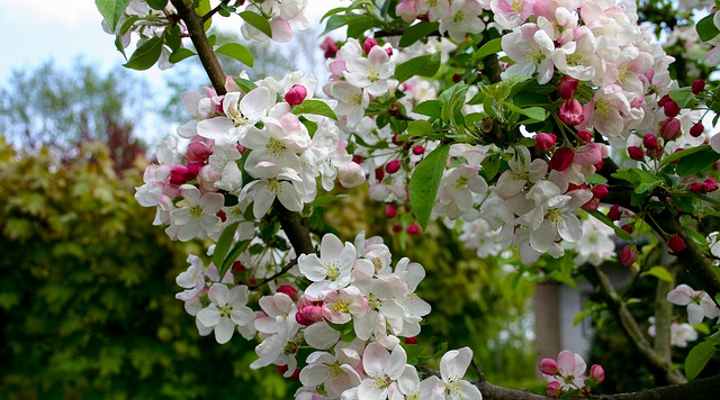
Lollipop crabapple is a dwarf tree suitable for landscaping compact spaces
‘Lollipop’ crabapple trees produce clusters of fragrant white flowers every spring. ‘Lollipop’ crabapples get their name from their unusual growth. The upturned branches give the crabapple tree a lollipop shape with its straight thin trunk and rounded growth. The compact dwarf crabapple tree keeps its shape without much pruning.
‘Lollipop’ crabapples grow up to 8 ft. (2.4 m) high and thrive in full sun in zones 4 to 8.
European Crabapple (Malus sylvestris)
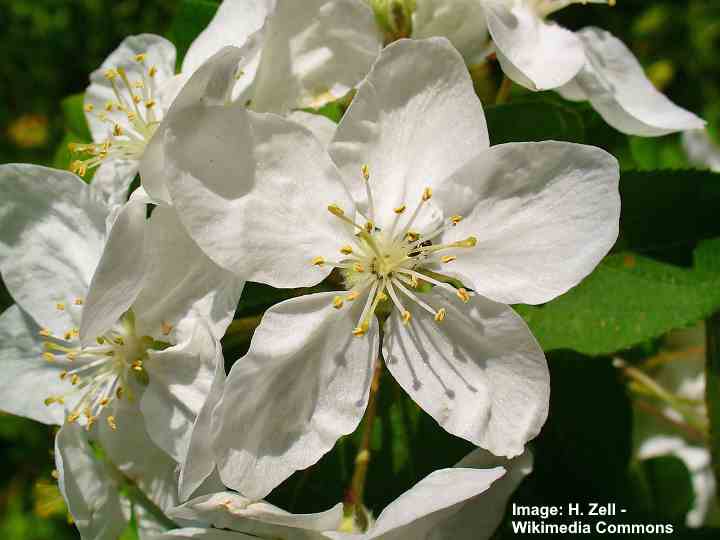
The European crabapple looks more like a shrub than a tree
European crabapples grow as a large bush rather than a tree and can grow up to 33 ft. (10 m) tall . This wild crabapple tree has thorns, glossy oval leaves with serrated edges, and small edible apples that measure 1” (3 cm) across. English crabapple trees produce white spring flowers that give off sweet aromas.
Royal Raindrops Crabapple (Malus ‘Royal Raindrops’)
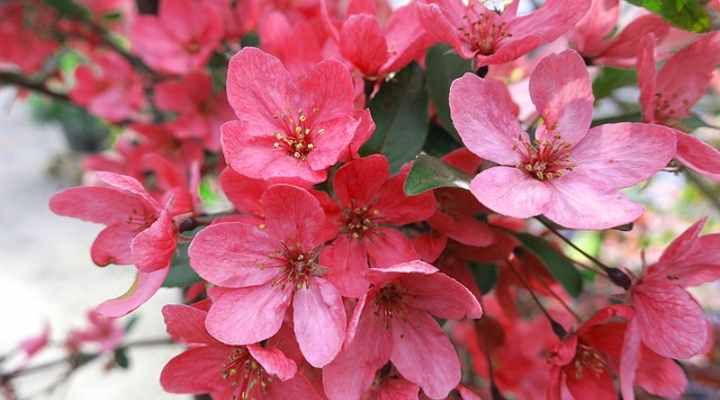
Royal Raindrops crabapple has magenta-pink flowers
The ‘Royal Raindrops’ crabapple tree is a delightful flowering tree with an abundance of magenta-pink flower clusters. The upright crabapple tree has a broad, round crown that is colorful for most of the year. After blossoming, the pink flowers contrast with reddish-purple leaves. Then, tiny clusters of red crabapple fruits appear in late summer and last until winter.
‘Royal Raindrops’ crabapple trees grow to between 15 and 20 ft. (4 – 6 m) tall with a spread up to 15 ft. (5 m). Grow as a flowering specimen tree in a sunny garden in zones 4 to 8.
Snowdrift Crabapple (Malus ‘Snowdrift’)
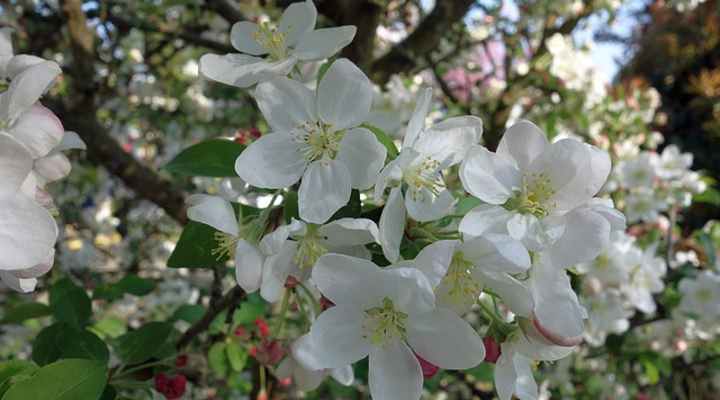
Snowdrift crabapple (Malus ‘Snowdrift’) has white fragrant flowers
‘Snowdrift’ crabapple trees are ornamental trees with fragrant clusters of snow-white flowers. As an upright fruit tree with rounded growth, ‘Snowdrift’ crabapples are stunning landscape trees. The white spring flowers cover the branches in spring and contrast with glossy-green leaves. The beautiful crabapple flowers then give way to small orangey-red fruits.
Crabapple ‘Snowdrift’ trees grow between 15 and 20 ft. (4.5 – 6 m) tall. Like most ornamental crabapple trees, they thrive in full sun and a wide range of soils. ‘Snowdrift’ crabapples are cold hardy in zones 4 to 8.
Red Jewel Crabapple (Malus ‘Red Jewel’)
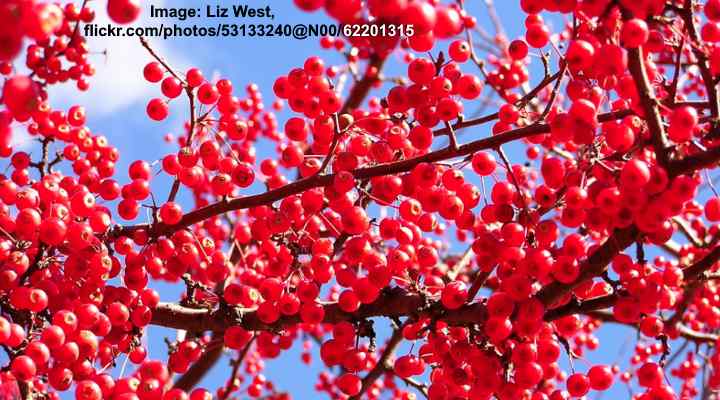
Red Jewel crabapple (Malus ‘Red Jewel’) has attractive small red fruits that look like berries
‘Red Jewel’ crabapple trees flower every spring with showy clusters of small white flowers. ‘Red Jewel’ crabapples grow up to 15 ft. (4.5 m) with an irregular spreading crown that’s 15 ft. (4.5 m) wide. These fruit-producing trees have small berry-like apples measuring about 1 cm across.
‘Red Jewel’ crabapples are attractive landscape trees with seasonal interest in spring, summer, fall, and winter.
Adirondack Crabapple (Malus ‘Admiration’)
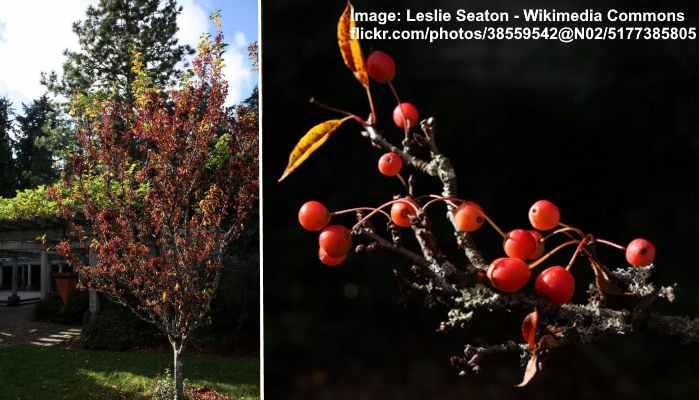
The small fruits of Adirondack crabapple (Malus ‘Admiration’) look like cherries
‘Adirondack’ crabapple trees are small deciduous trees that produce clusters of white flowers in late spring. The flowers from this ‘Adirondack’ crabapple tree are described as “large, waxy, fragrant, white blossoms.” After flowering, this crabapple species produces bronze-red fruits that look like clusters of small cherries.
‘Adirondack’ crabapples grow between 12 and 18 ft. (3.6 – 5.4 m) tall with a columnar growth habit. The compact flowering tree is ideal for small yards, as long it gets plenty of sunshine
Crabapple Purple Prince (Malus ‘Purple Prince’)

The pink-red flowers of crabapple Purple Prince (Malus ‘Purple Prince’) turn lighter pink later on
The fast-growing ‘Purple Prince’ crabapple tree blooms profusely with bright rose-red flowers. Towards the end of spring, the crabapple blossoms turn a light pink color. After the tree finishes flowering, the ‘Purple Prince’ crabapple produces purple fruits about half an inch (1.2 cm) in diameter. The edible crabapple fruits are excellent for making jams and jellies.
‘Purple Prince’ crabapples grow between 18 and 20 ft. (5 – 6 m) tall with a similar-sized spread. Plant this drought-tolerant crabapple tree in full sun and prune dead branches in the winter.
Sugar Tyme Crabapple (Malus ‘Sutyzam’)

Sugar Tyme crabapple (Malus ‘Sutyzam’) can be 15 – 20 ft. (4.5 – 6m) tall
The crabapple flowers on ‘Sugar Tyme’ trees are sweet-smelling white flowers with tinges of pink. When the crabapple tree blooms in spring, the sight is spectacular. Masses of white flower clusters cover the medium-sized tree. After blooming, small round red fruits appear that contrast with the rich green foliage.
Plant ‘Sugar Tyme’ crabapples in full sun in zones 4 to 8.
Crabapple Profusion (Malus x moerlandsii)
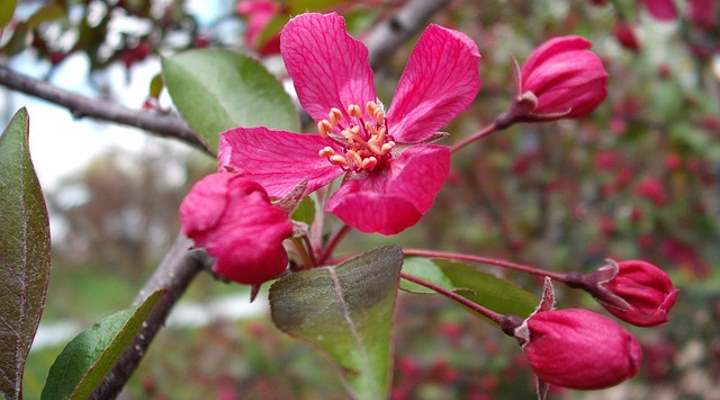
Crabapple Profusion (Malus x moerlandsii) has attractive deep pink flowers
Crabapple ‘Profusion’ trees are among the large species in the genus Malus. The large crabapple trees grow between 15 and 30 ft. (4 – 9 m) tall with a massive spreading crown of 35 ft. (10 m) wide. The ‘Profusion’ crabapple has all the features that make these trees spectacular—masses of fragrant flowers, small edible fruits, and stunning fall colors.
Crabapple ‘Profusion’ flowers are clusters of deep pink, fragrant flowers that bloom in mid-spring. The small round fruits measure less than an inch (1.5 cm) and can be any shade of yellow, amber, orange, or red.
Camelot Crabapple (Malus ‘Camelot’)
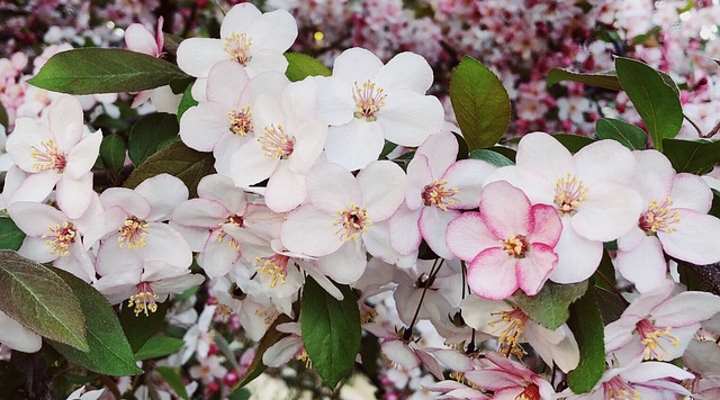
The decorative small Camelot crabapple (Malus ‘Camelot’) tree has white flowers with a hint of pink
‘Camelot’ crabapple trees are a type of dwarf landscaping tree that is colorful in all seasons. Malus ‘Camelot’ grows up to 10 ft. (3 m) tall and has a vast horizontally spreading crown up to 8 ft. (2.4 m) wide. Flowers on crabapple ‘Camelot’ trees are fragrant white with hints of pink hues. The small crabapple fruits are ideal for making jellies.
‘Camelot’ dwarf crabapples trees are perfect for planting in compact ornamental gardens. These pretty fruit trees are whitish-pink in spring, and then develop dark-green foliage that contrasts with abundant clusters of small red fruits.
Louisa Crabapple (Malus ‘Louisa’)
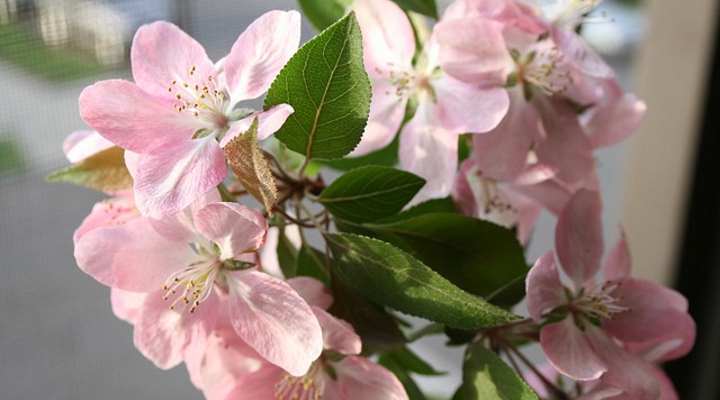
Louisa crabapple (Malus ‘Louisa’) is a small weeping tree with soft pink blooms
Crabapple ‘Louisa’ trees are small weeping crabapple trees with pastel pink-colored blossoms. Flowers appear on this crabapple variety in the middle of spring. The clusters of flowers on the drooping branches make the ‘Louisa’ crabapple highly ornamental. After flowering, small yellow or orange-colored fruits appear in the fall. ‘Louisa’ crabapples grow between 12 and 15 ft. (3.6 – 4.5 m) tall.
Plant ‘Louisa’ crabapple trees as a decorative specimen tree in small gardens.
Brandywine Crabapple (Malus ‘Brandywine’)
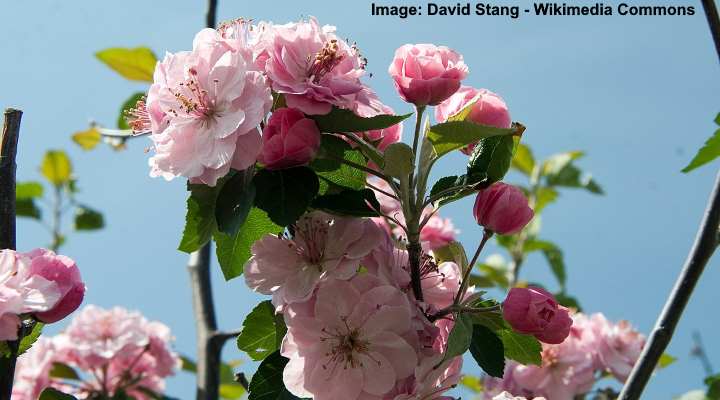
Brandywine crabapple (Malus ‘Brandywine’) has showy pink double blooms
‘Brandywine’ crabapple trees have showy flowers consisting of pink double blooms. The flowers appear in mid-summer along with bright cherry-red leaves. As the season progresses, the leaves turn dark green, and then small red edible fruits appear. Unlike other crabapple varieties, ‘Brandywine’ fruits drop fairly quickly, making this tree a “messy” tree in the fall.
‘Brandywine’ crabapple trees grow between 15 and 20 ft. (4.5 – 6 m) tall with a spread of up to 20 ft. (6 m).
Siberian Crabapple (Malus baccata)
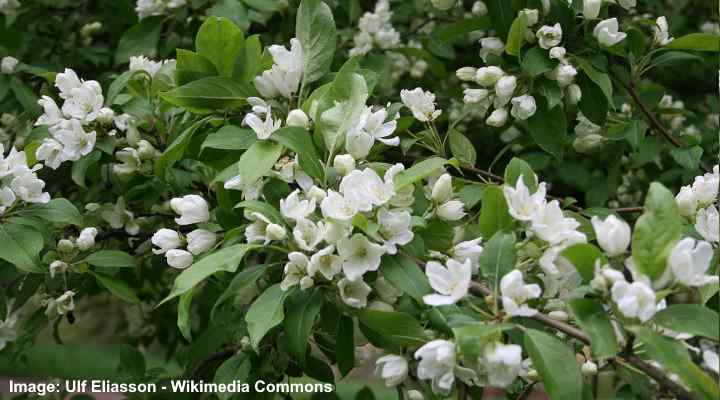
Siberian Crabapple (Malus baccata) is the most cold hardy among the Malus species
Siberian crabapples are tall crabapple trees that can reach 30 or 40 feet (9 – 12 m). The crabapple flowers are showy clusters of fragrant white flowers that bloom in early spring. After flowering, small yellow or red crabapples appear. The edible fruits are ideal as an ingredient in chutneys, jellies, or for pickling.
From all the Malus species, the Siberian crabapple is the most cold-hardy. The Malus baccata crabapple thrives in zones 2 to 7 as long as it gets plenty of sunlight.
If you’re looking for a smaller cold-hardy ornamental crabapple for growing in cold climates, choose the Malus baccata ‘Halward’ cultivar. This small crabapple only grows to 15 ft. tall (4.5 m).
Sweet Crabapple or Wild Crabapple (Malus coronaria)
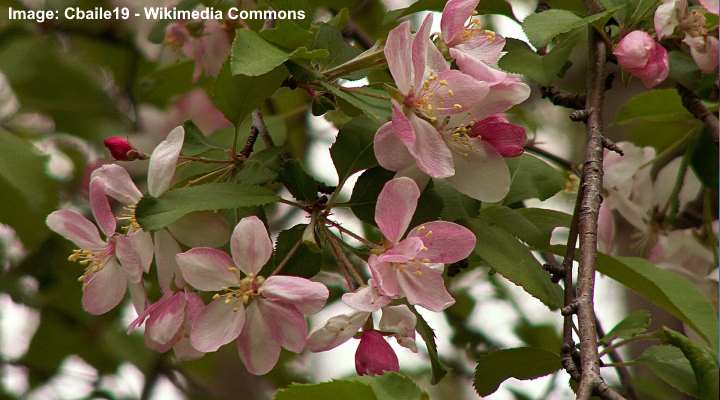
The pinkish-white flowers of sweet crabapple (Malus coronaria) have a pleasant scent
Also called the wild crabapple, the sweet crabapple tree has pinkish-white flowers that emit a pleasant fragrance. Wild crabapples produce largish round fruits that are 1.5” (4 cm) across. Despite being called the “sweet” crabapple, the juicy edible flesh has a distinctive sour taste.
Wild crabapples grow as large flowering shrubs or small-medium trees. The small crabapple tree grows up to 33 ft. (10 m) tall and has a broad, spreading crown.
How to Care for Ornamental Crabapple Trees
Decorative crabapple trees are easy to care for. After planting a young crabapple, you will need to water it frequently to keep the soil moist. However, after the tree is established, it becomes tolerant of drought, and you don’t need to water it so much.
Here are some handy tips on growing crabapple trees, so they fill your yard with pink and white blossoms every spring.
Water
Crabapple trees require frequent watering while the root system gets established. However, a mature tree doesn’t need water apart from regular rainfall. In dry seasons, it may be necessary to water the small trees to keep the ground moist.
Soil
Plant crabapple trees in fertile soil that has excellent drainage. Mixing in organic compost can help to give the tree enough nutrients.
Light
All varieties of crabapple trees thrive in full sun so that they produce masses of fragrant flowers. Ideally, crabapple trees need at least six hours of sunlight daily. If the tree grows in partial shade, it will produce fewer flowers and have an irregular shape.
Temperature
Trees in the Malus genus like crabapples grow best in temperate climates where they get warm summers and cold winters. Crabapples don’t grow well in hot or tropical climates. Crabapples thrive in zones 4 through 7 or 8.
Pruning
Crabapples keep their shape without much pruning. The only time to prune crabapple trees is in winter to remove dead, decaying, or diseased branches.
Related articles:
- Dwarf Fruit Trees to Grow Indoors or Outdoors
- Types of Flowering Trees with Pictures
- Small Trees for Landscaping Small Spaces
